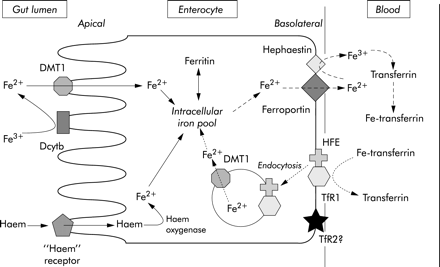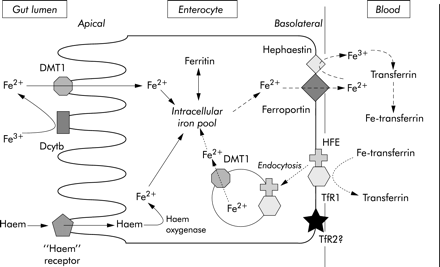Library
Mechanism of Iron absorption
- January 14, 2020
- Posted by: Namrata Chhabra
- Category: Learning resources Lecture notes Library Minerals Theory notes

Iron absorption takes place largely in the proximal small intestine and is a carefully regulated process. In general, there is no regulation of the amounts of nutrients absorbed from the gastrointestinal tract. A notable exception is an iron, the reason that absorption must be carefully regulated is that the body does not possess a physiological mechanism to eliminate much iron from the body. The small amount of iron that is lost each day (about 1-2 mg) is matched by dietary absorption of iron.
Mechanism of iron absorption
Iron is found in the diet as ionic (non-haem) iron and haem iron. Absorption of these two forms of iron occurs by different mechanisms. Absorption is a multi-step process involving the uptake of iron from the intestinal lumen across the apical cell surface of the villus enterocytes and the transfer out of the enterocyte across the basolateral membrane to the plasma. Ionic iron is present in the reduced (ferrous) or oxidized (ferric) state in the diet and the first step in the uptake of ionic iron involves the reduction of iron. Recently, a reductase that is capable of reducing iron from its ferric to ferrous state has been identified. It is a membrane-bound haem protein called Dcytb that is expressed in the brush border of the duodenum. Next, ferrous ion is transported across the lumen cell surface by a transporter called divalent metal transporter 1(DMT1) that can transport a number of other metal ions including copper, cobalt, zinc, and lead.

Figure- Showing the mechanism of iron absorption
Once inside the gut cell, iron may be stored as ferritin or transported through the cell to be released at the basolateral surface to plasma transferrin through the membrane-embedded iron exporter, ferroportin. The function of ferroportin is negatively regulated by hepcidin, the principal iron regulatory hormone. More the Hepcidin levels lesser is the iron absorption and vice versa. In the process of release, iron interacts with another ferroxidase, hephaestin, which oxidizes the iron to the ferric form for transferrin binding. Hephaestin is similar to ceruloplasmin, the copper-carrying protein.
The mechanism of absorption of haem iron has yet to be elucidated. Transfer across the brush border membrane is probably mediated by an unidentified haem receptor. Once inside, enterocyte iron is released from haem by haem oxygenase and either stored or transferred out of the enterocyte by a mechanism that is likely to be similar to that for ionic iron
Factors affecting iron absorption
Iron absorption is influenced by a number of physiologic states.
1) Erythroid hyperplasia stimulates iron absorption, even in the face of normal or increased iron stores, and in this state hepcidin levels are inappropriately low. The molecular mechanism underlying this relationship isn’t known. Thus, patients with anemias associated with high levels of ineffective erythropoiesis absorb excess amounts of dietary iron. Over time, this may lead to iron overload and tissue damage. In iron deficiency, hepcidin levels are low and iron is much more efficiently absorbed from a given diet; the contrary is true in states of secondary iron overload.
2) Hypoxia-Both the rate of erythropoiesis and hypoxia regulate iron absorption. Expression of ferroportin and Dcytb are increased in hypoxia, resulting in more iron absorption.
3) Body Stores– Iron absorption is stimulated if the levels of body stores are low. On the contrary, Hepcidin is produced excessively by hepatocytes when iron stores are full, hepcidin makes a complex with ferroportin promoting its degradation and thus iron is not transported out of the enterocyte into the blood. Iron remains inside the cell in the form of ferritin till the lifespan of the cell
4) Inflammation can also stimulate hepcidin production resulting in lowered iron absorption.
Author:Namrata Chhabra
Leave a Reply Cancel reply
You must be logged in to post a comment.
